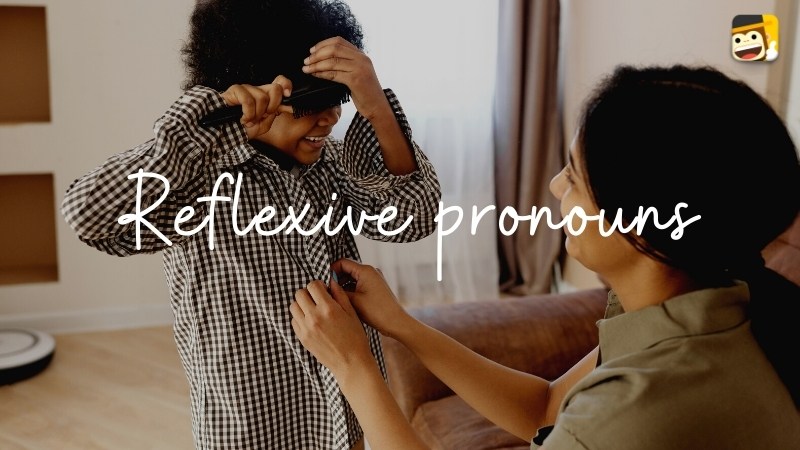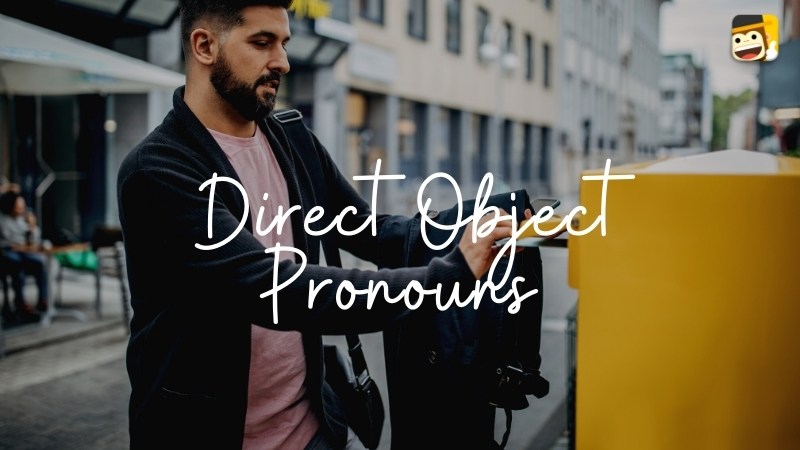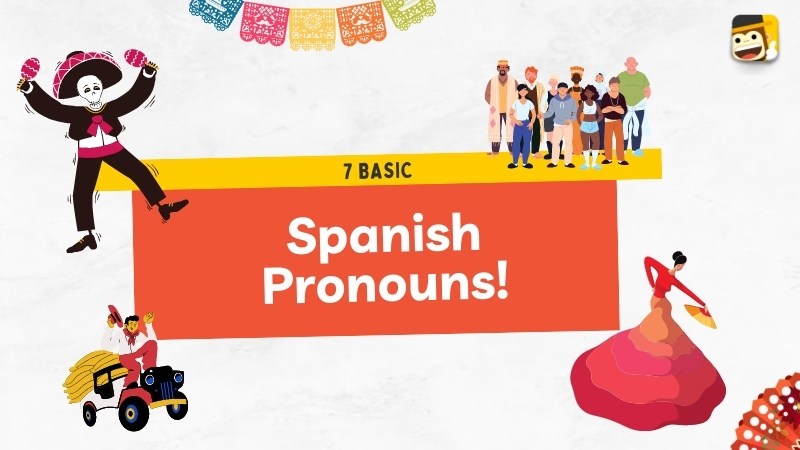One of the essential parts of learning any language is the pronouns. ‘I,’ ‘she,’ ‘he,’ ‘we, and’ ‘they’ appear in our sentences all the time, so you need to learn how to use them in Spanish. Luckily, mastering Spanish pronouns is a piece of cake, but it requires constant practice talking with native speakers or doing exercises on the Ling App.
This lesson requires you to completely understand before starting with verb conjugations, another essential part of the language that allows you to make your sentences.
Spanish Pronouns
What Is A ‘Pronoun’?
A pronoun is basically a word used to designate a thing without its name, common or proper. Its primary purpose is to avoid repetition.
Although Spanish uses verb conjugation to show the subject, we have times wherein pronouns play a pretty important role. That said, learning them is essential for a meaningful conversation and for making sentences coherently.
How To Say ‘Personal Pronouns’ In Spanish?
The word in Spanish for ‘personal pronouns’ is pronombres personales in the plural form and pronombre personal in the singular form.
What Are The Pronouns In Spanish?
Let’s dive into each type of the most indispensable pronoun in Spanish that you need to know. Read the Spanish sentence examples to practice and start using them in your daily conversations with your Spanish-speaking friends.
1. Personal Subject Pronouns (Pronombres Personales)
Personal subject pronouns in Spanish are the words that replace the subject, name, or noun. These words replace people, animals, or things whenever you don’t want to name them.

- I: Yo
- You: Tú (informal) / Usted (Formal)
- He: Él
- She: Ella
- We: Nosotros (Male) / Nosotras (Female)
- You: Ustedes (Plural and neutral)
- You: Usted (Singular and formal)
- You: Vosotros (Male/General) / Vosotras (Female)- Spanish from Spain)
- They: Ellos/Ellas
Example:
- ¡Tú nunca me escuchas! (You never listen to me!)
- Nosotros salimos a comer todos los viernes. (We go out to eat every Friday.)
- Ella es abogada en Estados Unidos. (She is a lawyer in the United States.)
In all the above sentences, it is not necessary to name the person we are talking about since it would already be understood in the context of the conversation. Therefore it is safe to use a subject pronoun.
2. Possessive Pronouns In Spanish (Pronombres Posesivos)
Possessive pronouns are words that replace the noun and indicate ownership of the subject, like in English ‘mine,’ ‘your,’ ‘theirs,’ etc.
You can use these words whenever it has already been clearly explained about the object being discussed. You can also use it when speaking about a particular thing, pointing at it, or indicating something.
The following is the list of possessive pronouns in Spanish that you can start using in sentences.
- Mine: El mío, los míos, la mía, las mías
- Yours: El tuyo, los tuyos, la tuya, las tuyas
- His/Hers/Its: El tuyo, los tuyos, la tuya, las tuyas
- Yours: El vuestro, los vuestros, la vuestra, las vuestras
- Ours: El nuestro, los nuestros, la nuestra, las nuestras
- Theirs: El suyo, los suyos, la suya, las suyas
Before the pronoun, you will find ‘el’ ‘la’ ‘los’ las,’ which are the equivalent of ‘the.’ We use this because in Spanish, it is essential to define the gender and the definite article needs to match the pronoun.
Example:
- A: ¿De quién es el auto parqueado en la puerta? (Whose car is parked at the gate?)
- B: ¡Es el mío, perdón! (It’s mine, sorry!)
- Este documento es suyo. (This document is yours.)
3. Reflexive Pronouns (Pronombres Reflexivos)
Reflexive pronouns have a significant role when using reflexive verbs. These verbs are those that indicate the action is done to oneself. For example, ‘vestirse’ (to dress).
As you can see, the verb ‘to dress’ (Vestir) in the reflexive form has a ‘se’ at the end of the word. That ‘se’ is the reflexive pronoun.
An example sentence would be: ‘Puede ir a vestirse.’ (You can go get dressed.)
Let’s see another example to understand these pronouns better. If I am the one dressing someone, for example, a baby, I can say ‘voy a vestirte’ (I am going to dress you.)

Example:
- Puede venir a la tienda para encontrarse conmigo. (You can come to the store to meet me.)
- Me estoy arreglando para ir al cine. (I’m getting ready for it to the movies)
- Nosotros nos fuimos temprano. (We left early.)
- Te lo prometo. (I promise you.)
4. Demonstrative Pronouns (Pronombres Demostrativos)
Use these pronouns to indicate the distance a person, animal, or thing maintains from the speaker.
You should also consider feminine and plural forms for each pronoun.
- This/These: Este/Esta/Esto/Estos/Estas
- That/Those: Ese/Esa/Eso/Esos/Esas
- That/Those: Aquel/Aquella/Aquello/Aquellos
Example:
- Estas manzanas están podridas. (These apples are rotten.)
- Esa camiseta me encanta, pero esta no tanto. (I love that shirt, but not so much this one.)
5. Direct Object Pronouns (Pronombre Objeto Directo)

When speaking, we can often find ourselves being too repetitive about nouns. To avoid this, we can use direct object pronouns. These words can refer to an object or person previously mentioned, so avoid repeating the same name repeatedly.
Example:
- Ayer envié la carta. (I sent the letter yesterday)
- La (it – feminine form) – pronoun
- Carta (letter) – Direct object
6. Prepositional Pronouns (Pronombres preposicionales)
The prepositional pronouns are words that appear after a preposition. A preposition is a term that helps describe where or how an object is in relation to something or someone, such as ‘in,’ ‘on,’ ‘after,’ and ‘for.’
In those cases, you can replace the noun with any of the following prepositional pronouns.
- Me: Mí
- You (informal): Ti
- You (formal): Usted
- Him: Él
- Her: Ella
- Us: Nosotros/Nosotras
- You (plural): Vosotros/Vosotras/Ustedes
- Them: Ellos/Ellas
Note: ‘vosotros’ is a term used by Spaniards only. In Latin American Spanish, we say the pronoun ‘ustedes’ to refer to others, and saying ‘vosotros’ sounds unnatural or reminds us of the language of priests at the church.
Examples:
- ¡El último pedazo de pastel era para ella! (The last piece of cake was for her!)
- Preparé estos cocteles para ustedes. (I prepared these cocktails for you.)
- ¿Esto es para mí o para ti? (Is this for you or for me?)
7. Indirect Object Pronouns (Pronombres de objeto indirecto)

To avoid repeating the noun, you can replace it with the indirect object pronouns. The variations are:
- To/for me: Me
- To/for you: Te
- To/for him, Her/It: Le/La
- To/for us: Nos
- To/for you all: Os
- To/for them: Les
So, how do you know when to use a direct or indirect object pronoun? Simple!
In the direct object, you must change the sentence to a question and find ‘what’ (¿Qué) is being discussed. While for the indirect object, the question is ‘to whom’ (¿A quién?).
For instance, in the sentence: ‘Hablas a tu mamá.’ (You talk with your mom.), the question would be ‘who are you talking to?’ and the answer is ‘to your mom.’ To change this sentence to avoid using ‘mamá’ and add a pronoun, we would say ‘Le habla a su mamá.’
Examples:
- Le compré el mejor regalo a mi papá por el día del padre. (I bought my dad the best gift for father’s day.)
- ¿Os invitaron a la fiesta de mañana? (Did they invite you to the party tomorrow?)
Just like ‘vosotros,’ ‘os’ is a word used only in Spain. In latin America we would say ‘¿Les invitaron a la fiesta?
Ready To Learn More Spanish With Ling?
Now that you have this basic information about Spanish pronouns, you can finally forget about being too repetitive when writing or speaking in this language.
Although it can be a bit complicated to understand at the beginning, as long as you practice daily, using pronouns will start to become natural in your daily life. Your next step is to increase your Spanish vocabularies like those related to professions, clothes, transportation, and sport.

If you need a companion to guide you through learning Spanish properly, you can choose the Ling App. An ideal, fun, and engaging language learning app with over 60+ languages, including Spanish. It’s full of exciting lessons specifically designed to help you be able to communicate with native speakers naturally. When learning a new language, you need practical information and quizzes to lose the fear of speaking. And that’s precisely what Ling can do.
Ling also has a chatbot that simulates real-life conversations. By simply using it daily after your language lessons, you will be able to hone your skills further and gain confidence in speaking with native speakers.
Curious to know how you can boost your Spanish skills with Ling? Try it out today! Download the app from App Store and Play Store to learn Spanish in the most fun and practical way!











